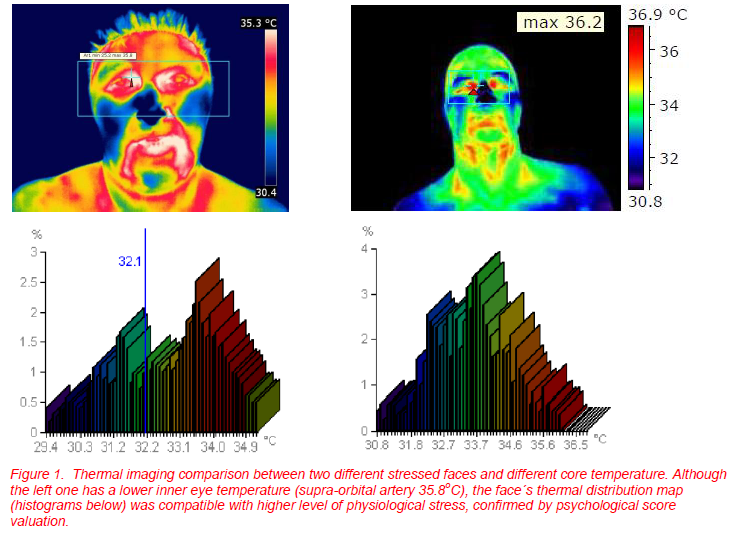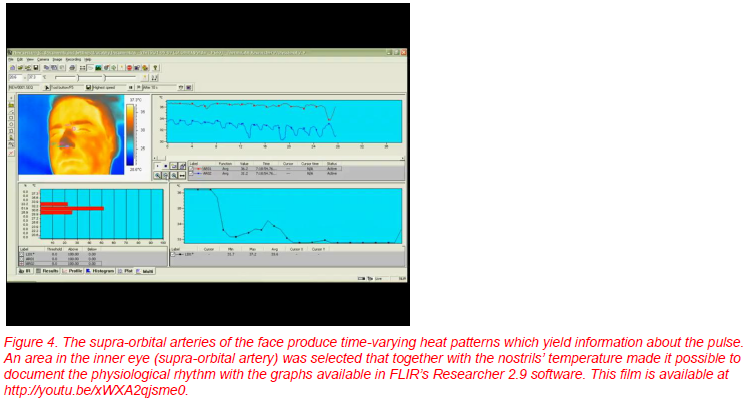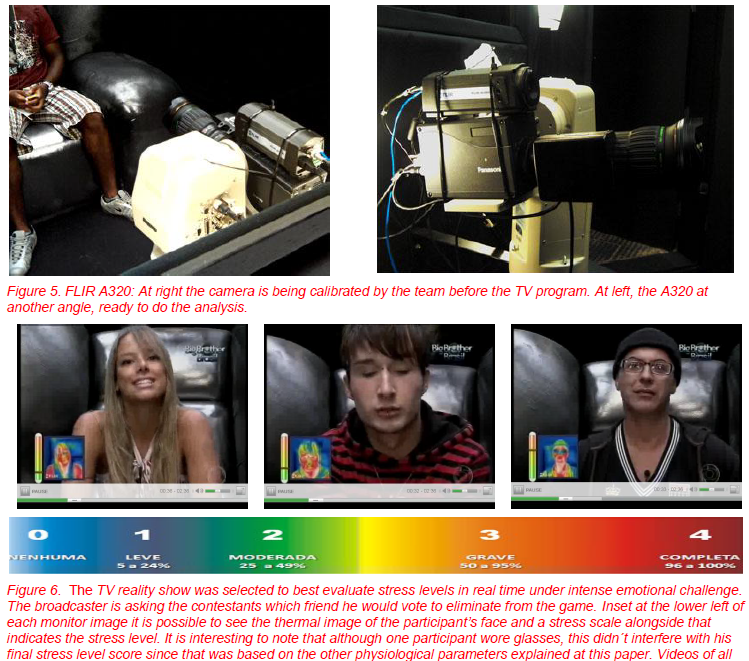IR Remote Sensing to Measure Human Stress Level
InfraMation 2010 Application Paper Submission
Marcos Leal Brioschi, Jorge Eduardo Fouto Matias, Manoel Jacobsen Teixeira, Jose Viriato Vargas. Sao Paolo University Hospital – Neurology and Psychiatry Department. Parana Federal University – Mechanical Department and Surgery Post-Graduation Department. InfraredMed - Medical Infrared Imaging Diagnostic, Brazil. www.infraredmed.org
ABSTRACT
The authors used non-invasive remote passive IR imaging to measure human vital signs in order to detect altered physiological status, defined as physiological stress. By means of statistical signal processing, an automated system can detect the level of physiological stress, analyzing functional human variables such as breathing, supra-orbital artery pulse, cold nose, ears and hands, dry mouth, flushing, and movement of the face. Breathing causes noticeable changes in temperature at the nasal area, which appear as periodic changes in the IR facial image. The supra-orbital arteries of the face produce time-varying heat patterns which yield information about the cardiac cycle, or pulse. Ear, nose, and hand vasoconstrictions and dry mouth diminish IR radiation proportionate to the stress level elevation, contrary to the hyper-radiation occasioned by the vasodilatation of the face. Normal human subjects were evaluated during a television reality show and the results were validated against standard approaches for physiological parameters measurement. The proposed method has medical, traffic accident, and public security applications as it is a non-contact method to monitor vital signs and detect driver's stress level and intent at a distance. Thermal imaging could be used at airports, for health screening, by police departments, in elder care, for workplace preventive care, and on vehicle dashboards. It can also detect "hostile thoughts" by screening suspicious people at checkpoints.
INTRODUCTION
Among the neurological effects that can be monitored by IR imaging, some authors have described a sympathetic nervous response to mental stress. IR imaging has numerous potential clinical applications in psychiatry both as a diagnostic as well as therapeutic tool (using biofeedback). IR can also effectively monitor mental stress induced by deception (“lie detection”).
Since sympathetic vasoconstriction or vasodilatation are much more sensitive manifestations of mental stress than perspiration, remote monitoring of subjects by IR (which also readily measures heart rate) is likely to be a far more effective “lie detector” than the best of polygraphs.
The purpose of this project was to detect malicious intent or "hostile thoughts" by screening people at border posts. It is a new technology that works in real time as opposed to after a crime is already committed. The same IR screening technology that was initially used for fever screening has now developed to measure pulse rate, skin temperature, breathing, facial expression, body (head) movement, and additional cues to see if you are a terrorist, or have intentions of causing harm. The technology is ready for use at airports, border posts, public places, and special events (stadiums, government departments).
METHOD AND RESULTS
Stress has been defined as a state that occurs when a living being is required to make abnormal or extreme adjustments, in either its physiology or behavior, in order to cope with adverse aspects of its environment and the management thereof. Hence, the measurement of stress is central to the assessment of a human being’s welfare.
Both the behavioral and physiological systems are involved in the response to stress. Factors that may influence a behavioral response include the individual's characteristics, previous experience, and the nature and severity of the stressor.
However, the measurement and interpretation of some behaviors can be subjective and the variation in responses can be misleading. For example, one man may act aggressively in defense whereas another man may withdraw in response to the same stressor. The more a person can predict and/or control his situation, the lower his stress levels.
The periorbital area is the facial area most affected by blood flow redistribution during anxious states. The corrugator muscle in the forehead is more active than usual when the individual experiences sustained stress.
As a result, more blood flows through the supraorbital vasculature, increasing the cutaneous forehead temperature (periorbital signal). Because stress levels may impact eye temperature, core temperature and thermal face distribution must be used for correction (Figure 1).

It was verified that the thermal distribution map of the face is more important than maximum temperature for stress diagnosis. The same principles must be applied for fever detection at different ambient temperatures.
Physiological stress can be detected not only by the thermal radiation over the supraorbital vessels (forehead temperature), but also by the temporal and nasal arteries areas (Figure 2).

Infrared thermography camera systems allow contact-free intranasal recordings of the nasal surface temperature and semi-quantification of nasal airflow. Intranasal heat exchange during inspiration and expiration can be used to monitor breathing rate (Figure 3).

As a consequence of the tissue thermal diffusion, modulation of skin temperature is strongest along the superficial blood vessels. Pulsating blood flow produces the strongest thermal signal on a superficial vessel. This signal is affected by physiological and environmental thermal phenomena. Therefore, the resulting thermal signal that is being sensed by the infrared camera is a composite signal, with the pulse being only one of its components. Considering that the blood vessel is a long, narrow structure, the pulse propagation phenomenon causes slight phase shift on the temperature profiles along the blood vessel (Figure 4).

When we were able to add the documented ability to monitor vital signs to the wide measurement potential offered by FLIR cameras and software, we could develop a complex system. For example, superficial hand face temperature differential can be used as stress indicator. Nasal temperature can also be a reliable and accurate indicator of a change from neutral to negative in emotional state of human beings. By means of statistical signal processing an automated system can detect the level of physiological stress, analyzing variables such as breathing, supra-orbital artery pulse, cold nose, ears and hands, dry mouth, flushing and movement of the face. Ear, nose, and hand vasoconstrictions and dry mouth diminish the IR radiation proportionate to the elevation of the stress level, contrary to the hyper-radiation occasioned by the vasodilatation of the face.
Thermographic test results on fifteen normal human subjects who were exposed to stressful situations during three months on a television reality show (BigBrotherBrasil10, Endemol Globo, Netherlands) were evaluated against the standard approaches for physiological parameters measurement Figures 5 and 6).

The results show that using IR signals as a measurement device enables a 96.3% success rate in stress level classification when compared with pulse measurement by Electrocardiography (ECG) recordings, breathing measurements and classic stress/emotional physiological scales.
Traditional polygraph stress detector testing requires the subject to be physically attached to a variety of sensors. This is impractical for scenarios such as checkpoints where a large number of individuals are entering at a high rate, necessitating the employment of other methods. Currently, checkpoint officers must make a quick decision to determine if an individual poses a security risk, and whether they should be searched.
This corrected stress level measurement by our IR imaging system gives the examiner excellent biometric and psycho-physiological parameters for computational psychology, particularly in deception detection. It can be used to help evaluate risk of car crashes or work-related accidents and also identify "hostile thoughts" by screening suspicious people at checkpoints in an unobtrusive and non-contact manner.
SUMMARY
The IR detection system can reveal stress levels that can help to avoid car crashes or work-related accidents. While existing screening technologies, such as IR biometrics, offer the potential to identify known terrorists, our IR technologies focus strictly on real-time psycho-physiological/behavioral patterns in an attempt to prevent the unknown terrorist from gaining access to his or her desired location. Our IR system based on FLIR technology has been proven to be effective for this purpose.
REFERENCES
Pavlidis, I. Levine, J. Monitoring of periorbital blood flow rate through thermal image analysis and its application to polygraph testing. Proc. Engineering in Medicine and Biology Society, 2001. Proceedings of the 23rd Annual International Conference of the IEEE.
Geisheimer J, Greneker EF. A non-contact lie detector using radar vital signs monitor (RVSM) technology IEEE Aerospace and Electronic Systems Magazine. 16(8):10-14, 2001.
Nhan BR, Chau T. Infrared thermal imaging as a physiological access pathway: a study of the baseline characteristics of facial skin temperatures. Physiol. Meas. 30 N23-N35, 2009.
Mizukami K et al. Telethermography in infant's emotional behavioral research. Lancet. 4;2(8549):38-9, 1987.
Kuznetsova GD, Nezlina NI, Petrova EV. Thermovisualization of the hemisphere asymmetry in the animal brain. Dokl Akad Nauk SSSR. 302(2):484-7, 1988.
Rysä P, Sarvaranta J. Thermography of the eye during cold stress. Acta Ophthalmol Suppl.123:234-9, 1974.
Boyce WT, Higley JD, Jemerin JJ, Champoux M, Suomi SJ. Tympanic temperature asymmetry and stress behavior in rhesus macaques and children. Arch Pediatr Adolesc Med. 150(5):518-23, 1996.
http://www.youtube.com/watch?v=2ndjRTJ3ogI&feature=player_embedded
http://www.youtube.com/watch?v=xWXA2qjsme0&feature=player_embedded
http://bbb.globo.com/BBB10/Noticias/0,,MUL1479584-17402,00-
CONFIRA+COMO+OS+BROTHERS+REAGIRAM+AO+ESTRESSE+DO+PAREDAO+EXTRA.html http://infrablogmed.infraredmed.org/index.php/2010/02/entenda-mais-sobre-a-avaliacao-de-stress-do-bbb10/ http://infrablogmed.infraredmed.org/index.php/2010/02/dicas-para-aliviar-o-calor-fantastico-07022010/ http://infrablogmed.infraredmed.org/index.php/2010/02/entrevista-canal-f-estudo-do-calor-no-rio-de-janeiro/
ACKNOWLEDGEMENTS
The authors wish to thank Tintin Razavian and FLIR Systems Brazil, Ricardo Damasco, Eduardo Azambuja and Luiz Gustavo Vassoler Zuca for providing the resources to make this work possible.
ABOUT THE AUTHOR
Dr. Brioschi has degree in Surgery from Universidade Federal do Paraná (1996), a Master's of Medicine from Faculdade Evangélica do Paraná (2000) and a Ph.D. in Surgery from Universidade Federal do Paraná (2003). He has done post-doctoral work at the Faculdade de Medicina do Hospital de Clinicas da Universidade de Sao Paulo, Neurology Department. He has experience in surgery, legal medicine, and clinical thermology (infrared imaging, thermography), with a concentration in thefollowing subjects: pain management, breast cancer, angiology, and surgery. He is president of Brazilian Thermology Society and a researcher at the Brazilian National Counsel of Technological and Scientific Development for the study and implementation of medical thermography.